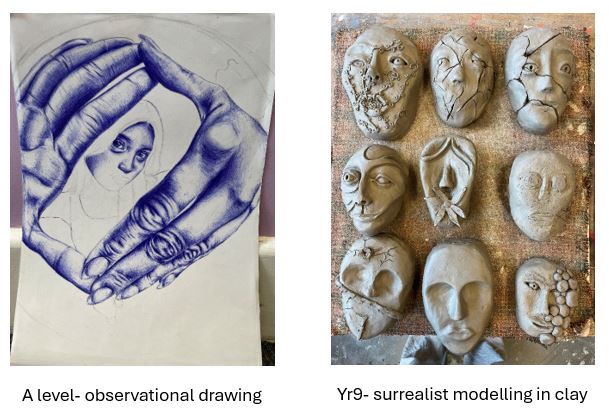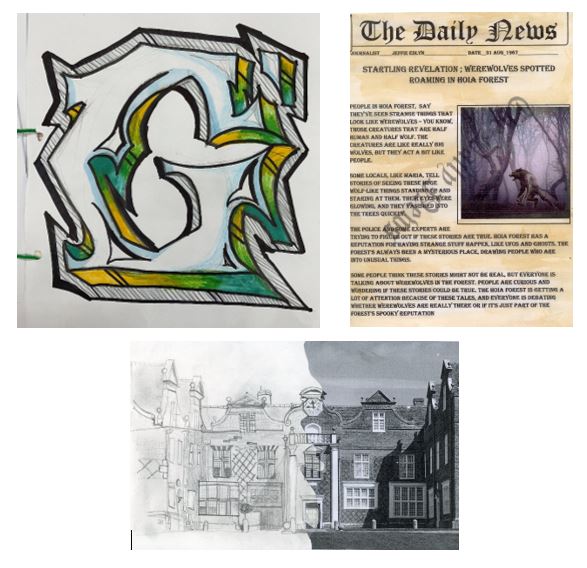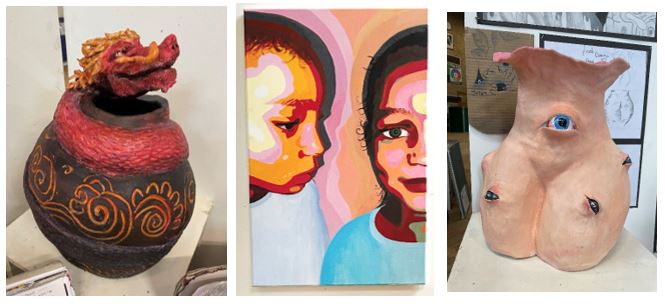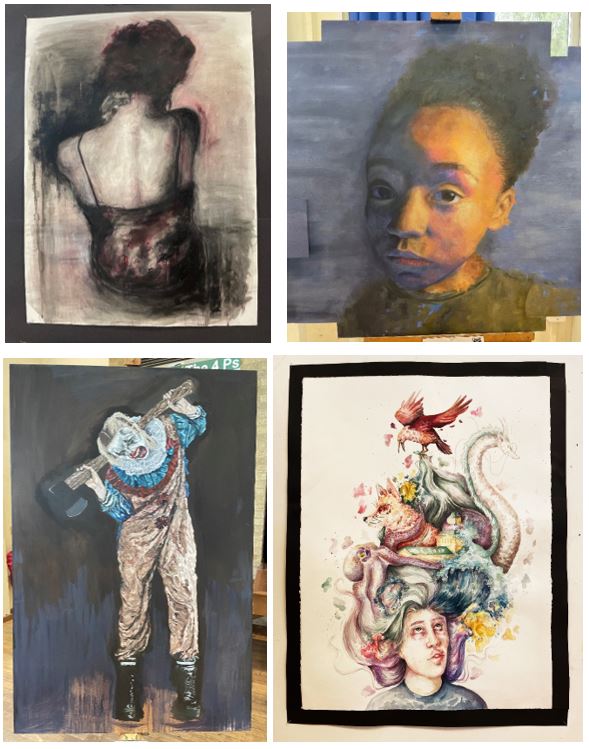Art
Subject Vision
Our vision for the art students at St Alban’s is to develop a lifelong curiosity to explore and create. Through our passion for Art and Design we aim to engage and inspire our students immersing them in all types of artworks. Underpinned with knowledge and skills we seek to provide a challenging and diverse curriculum which promotes critical thinking and reflective discussion. We aim for students to grow in confidence and commit to the process of creating, risk taking and visual discovery. Our curriculum and universal offer are designed with all students in mind ensuring they feel empowered to demonstrate courage on their independent and personal journey.
A knowledge rich, versatile curriculum that offers breadth in the opportunities for personal development underpinned by extensive visual skills.
The Art curriculum will give students the opportunity to:
Develop their understanding of artist practices through analysis of both traditional and modern art practice
- Explore an extensive range of practical skills and apply their knowledge of techniques and processes
- Produce personal creative work, exploring their ideas and recording their experiences.
- Become critical thinkers and creative problem solvers.
- Understand the visual world around us.
Key Stage 3 Curriculum Overview
|
|
Year 7 |
Year 8 |
Year 9 |
|
Aut.1 |
The Formal Elements: Line, Tone and Colour |
Fantastic Creatures: Mythology, hybrid designs 3D clay modelling |
Deconstructed portraits: Response to Jover focused on an icon |
|
Aut.2 |
The Formal Elements: Pattern and Printing |
Fantastic Creatures: Creature scrolls |
Deconstructed portraits: Response to Jover focused on an icon |
|
Spr.1 |
Alphabets: Themed letter designs, Illuminated letters |
Food and Drink: Observational colour studies Paper drawing |
3D Graffiti letter: Graffiti lettering, street art design and making |
|
Spr.2 |
Alphabets: Decorative clay tiles |
Food and Drink: Pop art printing |
3D Graffiti letter: Construction and decoration of letter |
|
Sum.1 |
Architecture: Observational drawing/split drawing |
Surrealism: Metamorphic drawings Impossible objects |
Black and White: -mark making in line/tone -pencil drawing -pointillism -negative drawing |
|
Sum.2 |
Architecture: Stained glass window Gargoyles |
Surrealism: Dada poetry Surrealist collage |
Black and White: -graphic tablet drawing -monprinting -geometric drawing |
Where does this subject lead me?
At KS4 Art is an options subject. This is the best opportunity to understand creative practices and develop practical skills. Art is a very personal subject that develops work towards a visual portfolio and multiple career opportunities within the creative industries.
The skills taught in Art at Key Stage 3 are valuable for a wide range of other subjects, including:
- Technology (Fashion, Textiles, Graphics)
- Photography
- Performing Arts
- Creative writing/English
Career Pathways
In many jobs being able to think and plan creatively can be an advantage. Having a range of skills to creatively problem solve ideas and find alternative solutions is essential in the modern world.
There are many careers that require creative and artistic skills including architecture, fashion design, advertising, media make-up and floristry.
- BBC Bitesize website: videos of young people who are working in jobs that use art and design
- Careers Pilot: example careers that this subject can lead to
- Creative Industries: explore a wide selection of creative careers
- Apprenticeship courses: Info on what an apprenticeship is and courses available
Key Stage 4 Curriculum Overview
|
|
Year 10 |
Year 11 |
|
Aut.1 |
Structures 2D: Contextual and practical response to artist exploring Line and Tone |
Structures 3D: Realisation in 3D |
|
Aut.2 |
Structures 2D: Contextual and practical response to artist exploring colour.
|
Personal outcome |
|
Spr.1 |
Structures 2D: Painting skills Drawing, painting, mixed media approaches to plan for Outcome 1
|
ESA: Research and ideas |
|
Spr.2 |
Structures 2D: Realisation of Outcome 1 |
ESA: Planning and experimenting |
|
Sum.1 |
Structures 3D: Approaches to clay and sculpture |
ESA: Final practical exam |
|
Sum.2 |
Structures 3D: Model making, planning in 3D |
|
How is the course structured?
Component 1. Personal Portfolio- The coursework is split into two main approaches and preparation for these will begin at the end of Year 9 where key skills are explored for each of the components.
Structures 2D- An introductory theme that allows students freedom to interpret new artist techniques including drawing approaches (traditional and digital), painting, printmaking, mixed media, ceramics and sculpture. Photography and darkroom lesson are also built into Year 10. A final outcome is produced in the Spring term.
Structures 3D- An extended project that explored disciplines in ceramics and sculpture working towards a final outcome of students’ choice in 3D.
Component 2. Externally Set Assignment- The theme is set by the exam board Pearson Edexcel and students prepare for the exam from January to May. The exam is 10 hours.
|
Students will be expected to work in sketchbooks for both coursework and exam preparation. Other practical work such as modelling and 3D sculptures will also count towards the assessment alongside the final outcomes. |
How is it assessed?
Component 1 (coursework) is worth 60% of overall grade.
Component 2 (Externally Set Assignment) is worth 40% of overall grade.
Work is assessed regularly throughout the course and feedback is given verbally and formally to ensure students make progress with knowledge and skills in each component.
What can it lead to?
Many students go on to study a variety of creative courses at university such as Fine Art, Illustration, Fashion, Photography, Animation as well Architecture and Engineering. These courses all require creative minds and a creative problem-solving approach alongside excellent practical skills.
The GCSE Art course provides an excellent basis for A Level both in Art and complements other creative courses such as Textiles or Photography.
Employers, Sixth Form Colleges and Universities value the important range of transferable creative skills that Art and Design delivers.
Key Stage 5 Curriculum Overview
|
|
Year 12- Art and Design |
Year 13- Art and Design |
|
Aut.1 |
Visual Skills 1, 2- drawing/foreshortening, digital editing. |
Component 1- consolidation of ideas |
|
Aut.2 |
Visual Skills 2, 3- digital editing, printmaking. |
Component 1- realisation |
|
Spr.1 |
Visual Skills 4- portrait painting in acrylic and oils. Visual Problem Solving Introduction to Component 1- Who Inspires you? |
Component 2- ESA |
|
Spr.2 |
Component 1- Personal Investigation. Research and artist experimentation |
Component 2- ESA |
|
Sum.1 |
Component 1- Personal Investigation. Ideas and planning |
ESA and final exhibition |
|
Sum.2 |
Component 1- Personal Investigation. Yr12 PPE outcome |
|
Entry Requirements
A grade 5 GCSE Art and Design or similar creative GCSE such as Textiles or Graphics.
Overview
The AQA A Level syllabus is broad and visually challenging to give you every opportunity to excel as a creative. Underpinned by knowledge and skills, the A Level Art and Design course offers a wide variety of practical experiences through lessons, gallery visits both regional and abroad, and established links with practicing artists. The skills explored will be diverse, challenging and broadening. Amongst them you will develop a working knowledge of materials, practices and technology within Art, Craft and Design and learn the skills to interpret and convey your ideas and feelings though your own artistic journey. You will improve your imagination and creativity through experimental and analytical work which are key skills transferred to all academic practices. You will also develop a specialist critical vocabulary and the knowledge and understanding of the place of Art, Craft and Design in history and in contemporary society with an awareness of both traditional and new media. The Art course is the perfect opportunity for digital designers, multimedia and traditional artists.
Where does this subject lead me?
Our Art and Design A-Level course offers students a pathway to a creative career. Students with a wide creative skill set have an advantage in any career. Students may go onto to study a Foundation Diploma in Art and Design or degree course for a career for which an art background is relevant. These might include Fine Art, Architecture, Advertising, Illustration, Publishing, Theatre/Interior Design or gallery/museums. Students will be well prepared for careers underpinned by creative skills and enthusiasm for visual learning. Be aware there is a surge in demand for multimedia artists, animators, and illustrators – especially those who are computer and technology-savvy, due to companies’ demand for advertising in online and digital formats. Fine artists can reach a worldwide market at the click of a button and the skills you learn will be relevant to all avenues of life.
Studying art equips you with a whole set of transferable skills; creative problem solving, verbal reasoning, critical thinking, communication, risk taking, the ability to use experiment and resolve issue, time management and visual organisation.
Careers Information
There is a huge variety of career information on different routes into the creative industries and the types of jobs available with a creative portfolio.
https://careerpilot.org.uk/job-sectors/subject/art#link-1
https://discovercreative.careers/
https://creativeaccess.org.uk/
https://www.apprenticeships.gov.uk/apprentices/browse-by-interests/creative-design#




